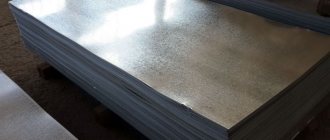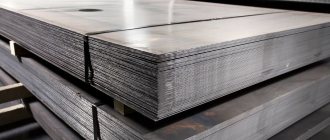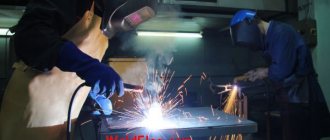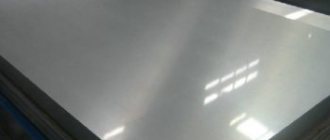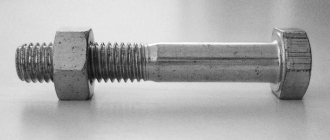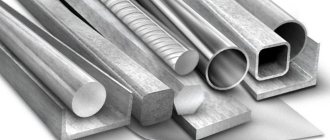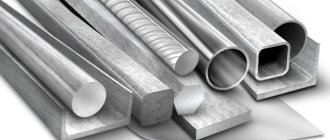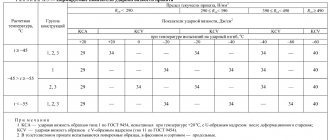home
About company
Directory
Galvanized sheet
Corrosion destroys about 10% of all metal produced in the world; every sixth or seventh blast furnace works in vain: the steel smelted in it completely turns into rust within a year. Even in developed countries with high technology, the damage caused by corrosion can reach 4% of GDP. One of the most effective ways to protect against corrosion is to apply a protective layer of zinc to the surface of metal structures. Galvanizing is several times cheaper than paint and varnish coatings, and, at the same time, extends the service life of the metal by 30-40 years.
Sheet (also rolled) galvanized steel is produced:
- hot galvanizing of thin-sheet cold-rolled steel coils;
- by applying galvanic coating;
- spraying (gas-thermal method);
- thermal diffusion galvanizing.
The most common is hot-dip galvanizing; this technology makes it possible to produce a strong and durable anti-corrosion coating with a thickness of 10 to 60 microns at the lowest cost. Matte white, sometimes with a gray tint without shine, the coating obtained by hot-dip galvanizing is inferior in decorative qualities to shiny and silver galvanized ones, but has greater hardness and excellent strength characteristics.
Galvanized sheet GOST 14918-80 (technical conditions and requirements)
Standard 14918-80 applies to cold-rolled carbon steel 0.5 to 2.5 mm thick that has been continuously hot-dip galvanized (which results in the formation of a corrosion-resistant Zn-Fe alloy on the metal surface). For galvanizing low-carbon steels, technical conditions are determined separately, by standard R 52246-2004.
| № | Classification of galvanized steel GOST 14918-80 | Groups, categories, classes | Abbreviation (used for symbolic designation) |
| 1 | Assignment Groups | General purpose | HE |
| For cold stamping | XSh | ||
| For cold profiling | HP | ||
| For painting | PC | ||
| 2 | Hood categories | Very deep draw | VG |
| Deep | G | ||
| Normal | N | ||
| 3 | Tread quality | Reduced thickness variation | UR |
| Normal thickness variation | HP | ||
| 4 | Galvanization layer thickness, class | I class | 1 |
| II class | 2 | ||
| Elevated | P | ||
| 5 | Appearance of galvanization/type of crystallization pattern (by agreement with the customer) | With crystallization pattern | KR |
| Without crystallization pattern | MT |
Dimensions of wall profiled sheets
Galvanized products are in steady demand in many areas of industry:
- Construction - products are used for roofing work, as fences, floors, in a variety of modular designs, galvanized construction and painting tools are produced.
- Mechanical engineering - car bodies, refrigerator or washing machine bodies, galvanized tanks for liquids and much more.
The demand for galvanized steel sheets in construction and in various industries is enormous. Metal tiles, fencing made of corrugated sheets, mounting profiles, body parts of cars and ships, pipes for various purposes, elements of the drainage system, containers for transporting liquids - this is not a complete list of products where the metal segment is used.
Based on the standards for the use of the material, it is divided into the following types, which are indicated by markings.
- OH – general purpose.
- KhSh – used for cold stamping.
- HP – used in cold profiling.
- PC – galvanized, awaiting painting work.
The low weight characteristic of galvanized sheets has made it popular in the manufacture of packaged products and household items. As an example, let us give the following figures: one square meter of galvanized steel 0.5 mm thick weighs only 4.13 kg.
When subsequently treated with a polymer coating, the product receives additional protection from precipitation and mechanical influences. Such products are widely used as roofing materials and in the construction of fences.
If we summarize all the positive qualities of this popular metal, we get the following picture.
- It has a long working life, which amounts to decades.
- Great design. Galvanization looks great on its own, without any finishing.
- Reliable material. Not afraid of moisture, temperature changes, ultraviolet rays. It is resistant to mechanical stress, has good ductility, and has excellent anti-corrosion qualities.
- Environmentally friendly material.
- Production variations. Galvanization can be produced with different thicknesses of steel and the galvanized coating itself. It is offered to consumers in rolls or sheets.
- Has the ability to restore damaged surfaces in areas of processing, perforation, cutting. A kind of tightening of the edges of the sheet occurs.
- Reasonable price for galvanized sheet.
Various operations can be carried out with galvanizing. Thus, with the help of stamping, popular building materials such as metal tiles or corrugated sheets are obtained. Rolling, bending and drawing are used to produce siding components, profile and drain pipes, etc.
Among the disadvantages, which are practically non-existent, we note minor difficulties during welding work, as well as the fact that this product requires additional actions before painting. It should also be taken into account that over time, galvanized sheets “age” and lose the original thickness of their protective coating. The operating temperature has an upper limit: at 420 degrees it begins to melt.
However, using sheets that are too large or too small is usually not very convenient. The most popular are 1000x2000 mm or 1250x2500 mm and up to 1 mm thick.
The range of materials in terms of their main indicators is quite large, so before choosing, you should decide what size sheet will be most suitable for carrying out certain work.
You should be especially careful when creating a roofing covering, since a large number of factors must be taken into account:
- Roof dimensions;
- Possibility of delivery of sheets of certain sizes;
- Technological methods for lifting to the roof;
- Unloading methods and many other nuances.
As a rule, when building private houses or country cottages, standard sheets are used, the dimensions of which are 1 by 2 meters with a thickness of 0.55 mm. Instead, sometimes they take material 1250 mm by 2500 mm.
Not a single state standard strictly stipulates the weight of one galvanized sheet. However, this indicator is often very important, especially when you need to find out whether the vehicle can withstand the load. To calculate the mass of one sheet, you can use an indicator such as the specific gravity of the material, which is approximately 7.8 g per cubic centimeter.
Galvanized profile sheet, the dimensions and thickness of which depend on the application, is rolled metal with an anti-corrosion coating. Steel blanks are cold rolled on special machines that form so-called corrugations. They have a trapezoidal shape and act as stiffeners. It is thanks to them that steel profile sheets have an increased level of strength.
The shape of the profile and the height of the ribs affect the strength of the steel sheet. This type of corrugated sheeting is used for various purposes - from installing gates, fences and ending with roofing.
The main advantages of profile sheets are ease of installation and maintenance, durability, versatility and low cost compared to analogues. In addition, corrugated sheets have a low specific weight: depending on the thickness of the metal and the presence of a polymer coating, a square meter of this material weighs from 5 to 10 kg. The most durable metal profile copes well even with load-bearing functions.
Among the disadvantages, it is worth noting the high noise level during physical impact on steel sheets. For example, during rain, a corrugated sheet enhances the sound of drops falling on it. Another disadvantage of galvanized sheets without polymer coating is their unattractive appearance, but not everyone shares this opinion. It has a slightly yellowish steel color and, due to the lack of paintwork, is more affordable.
Standard galvanized iron sheet sizes range from 2.4 to 12 meters (NS). Depending on the area of application, the size has different multiples. So, for example, roofing sheets (H) have a length from 3 to 12 meters and a multiplicity of 25 cm, and rolled products for wall fencing (C) - from 2.4 to 13 m with a multiplicity of 30 cm. However, upon individual orders, manufacturers produce sheets of any sizes.
Roofing sheets (marked “N” - load-bearing) are also used for the construction of load-bearing and supporting structures. Thanks to their high profile, large metal thickness and wide wave pitch, these sheets can withstand heavy loads. For example, with a certain installation, H75 grade corrugated sheeting with a sheet thickness of only 0.9 mm can withstand a load of up to 720 kg/m2.
- C – wall profiled sheet;
- 21 – profile height;
- 0.45 – thickness of the metal base;
- 750 – width of the profiled sheet;
- 11000 – length of the profiled sheet.
In most cases, the following grades of sheet profiles are used for the installation of walls, fences and gates: C8, C10, C18, C21, C44.
C8 corrugated sheet has a useful length from 1 to 11.5 m and is often used for installation of facade and wall coverings, as well as ceilings. The height of the corrugation is 8 mm, and the thickness of the sheet is from 0.4 to 0.7 mm, making this brand one of the most affordable. Another advantage of this type of corrugated sheet is its low weight, which greatly facilitates installation, transportation and increases economic benefits in general.
Galvanized profiled sheet of grade C18, despite its belonging to the category of wall profile, is often used for roofing installation. As you know, one of the disadvantages of a seam roof is noise during strong gusts of wind. The design of the C18 brand with small stiffening ribs and wide shelves almost completely solves this problem.
Corrugated galvanized sheet of grade C21 has a high level of rigidity, despite the small profile height. The waveforms ensure reliable joining, and their frequency and symmetry increase the stability of the sheet. Profiled sheet C21 is used for the installation of fences and walls, as well as for the roofing of residential buildings.
The most popular brands of galvanized roofing sheet are H60 and H75.
The H60 brand is distinguished by high performance characteristics, versatility and a relatively low price. It is often used as an independent roofing profile and for the installation of formwork. The useful width of the profiled sheet is 8.45 meters.
It is believed that N75 grade corrugated sheet metal is the most popular roofing metal product. It is used in many areas of modern construction for the installation of membrane-type roofing, seam roofing and permanent formwork. This brand is made from the highest quality steel and is the leader among roofing corrugated sheets in terms of production volumes. Tall, rigid ribs and thick galvanized steel sheets can withstand enormous loads.
The most popular universal brands of corrugated sheets are NS44 and NS57.
We invite you to familiarize yourself with Moldings for walls - 100 photos of the best modern design ideas
NS44 is a typical representative of the class of universal corrugated sheets. It is equally suitable for both roofing and wall coverings. The increased strength of this brand allows you to fasten the rolled steel in increments of 2.5 meters.
NS57 differs from the previous one in its higher resistance to mechanical loads. The maximum thickness of the steel sheet is 1 mm, and the height of the waves is 60 mm.
Of course, these are not all the sizes of galvanized profile sheets. Their range is much wider, and it is unlikely that it will be possible to list all the features of each brand in one article. However, this information is quite enough to select profile rental for a fence or house.
General recommendations for choosing corrugated sheets for your home:
- For roof installation, it is recommended to use a galvanized profile marked H and a sheet height of 20 mm.
- For the installation of fences, gates or walls, it is advisable to use profiled sheets up to 20 mm high. Brands C10 and C14 are good.
The color of the rental is a matter of taste. But one thing is for sure - it is better to choose corrugated sheeting with a protective paint coating. It is slightly more expensive than a simple galvanized profile, but has a longer service life and a more aesthetic appearance.
Galvanized products are in steady demand in many areas of industry:
- Construction - products are used for roofing work, as fences, floors, in a variety of modular designs, galvanized construction and painting tools are produced.
- Mechanical engineering - car bodies, refrigerator or washing machine housings, galvanized tanks for liquids and much more.
| Type of corrugated sheet | Sheet thickness | Cost, rub.m.sq. | ||
| Profmetall LLC | LLC "Krona" | Yugmontazh LLC | ||
| PS-8 | 0,35 | 167 | 143 | 159,01 |
| 0,40 | 175 | 154 | ||
| 0,45 | 196 | 176 | 201,97 | |
| 0,50 | 208 | 191 | 220,16 | |
| 0,55 | 225 | 218 | 243,19 | |
| 0,60 | 246 | 237 | ||
| 0,65 | 264 | 253 | 283,17 | |
| 0,70 | 279 | 269 | 301,70 | |
| PS-20/PK-20 | 0,35 | 126 | 149 | – |
| 0,40 | 183 | 160 | 181,55 | |
| 0,45 | 204 | 183 | 230,61 | |
| 0,50 | 217 | 199 | 251,37 | |
| 0,55 | 235 | 228 | 277,67 | |
| 0,60 | 257 | 246 | – | |
| 0,65 | 276 | 265 | 323,32 | |
| 0,70 | 291 | 273 | 344,48 | |
| PK-44 | 0,40 | 236 | – | – |
| 0,45 | 263 | 208 | – | |
| 0,50 | 287 | 208 | 249,24 | |
| 0,55 | 306 | 226 | 275,31 | |
| 0,60 | 325 | 249 | 300,20 | |
| 0,65 | 344 | 288 | 320,57 | |
| 0,70 | 358 | 306 | 341,55 | |
| PN-75 | 0,70 | – | 385 | 482,39 |
| 0,80 | 619 | 437 | 541,94 | |
| 0,90 | 681 | 490 | 606,25 | |
| 1,00 | 735 | 550 | 671,44 | |
| 1,10 | 789 | – | – | |
| 1,20 | 859 | – | – | |
- WITH - ;
- 21 – profile height;
- 0.45 – thickness of the metal base;
- 750 – width of the profiled sheet;
- 11000 – length of the profiled sheet.
- The H57 profile is used for roofing with sheathing pitches of up to 3 meters, sheet reinforcement of reinforced concrete floors, and stiffening diaphragms in buildings with a metal frame.
- H60 is characterized by greater thickness and height of the corrugation. Application areas are similar to H57.
- H75 is one of the most powerful modifications of load-bearing flooring; it can be used for constructing roofs with sheathing pitches of up to 4.5 m, manufacturing structural elements for the construction of temporary and prefabricated buildings, for external walls of garages, change houses, and retail outlets.
| Profile brand | Sheet thickness, mm | Sheet length, m | Sheet width, mm | Profile height, mm | Trapezoid pitch, mm | |
| General | Working | |||||
| H57 | 0,6, 0,7, 0,8, 0,9 | 0,5-14,0 | 801 | 750 | 57 | 187,5 |
| H60 | 0,7, 0,8, 0,9, 1,0 | 0,5-14,5 | 902 | 845 | 60 | 211,25 |
| H75 | 0,7, 0,8, 0,9, 1,0 | 0,5-14,5 | 800 | 750 | 75 | 187,5 |
| Profile brand | Sheet thickness, mm | Sheet length, m | Sheet width, mm | Profile height, mm | Trapezoid pitch, mm | |
| General | Working | |||||
| NS35 | 0,5, 0,55, 0,6, 0,65, 0,7, 0,8, 0,9 | 0,5-12,0 | 1060 | 1000 | 35 | 200 |
| NS44 | 0,4, 0,5, 0,7, 0,8 | 0,5-12,0 | 1070 | 1000 | 44 | 250 |
- C8 – wall cladding, installation of panel and enclosing structures. Can be used for roofs with continuous sheathing;
- C10 – installation of fencing, construction of walls and wall structures in the manufacture of change houses, small trade stalls, for installation of roofs with a sheathing pitch of 0.8 m;
- C18 – cladding of walls, ceilings, roof structures with frequent lathing, the angle of inclination of which does not exceed 25°;
- C21 - compared to previous products, it has greater strength and rigidity, and is used for erecting fences, constructing outbuildings, and installing roofs with a sheathing pitch of no more than 0.8 m.
| Profile brand | Sheet thickness, mm | Sheet length, m | Sheet width, mm | Profile height, mm | Trapezoid pitch, mm | |
| General | Working | |||||
| C8 | 0,55, 0,65, 0,7 | 0,5-12,0 | 1200 | 1150 | 8 | 115 |
| C10 | 0,4, 0,45, 0,5, 0,6, 0,7, 0,8 | 0,5-12,0 | 1150 | 1100 | 10 | 115 |
| C18 | 0,4, 0,45, 0,5, 0,6, 0,7, 0,8 | 0,5-12,0 | 1023 | 1000 | 18 | 115 |
| S21 | 0,4, 0,45, 0,5, 0,55, 0,6, 0,65, 0,7, 0,8 | 0,5-12,0 | 1051 | 1000 | 21 | 100 |
how much does a sheet of iron cost for a roof depending on the width
We recommend
According to professionals, the most convenient to use and fairly reliable option for roofing iron is considered to be a material with a thickness of 0.45 - 0.55 mm.
Galvanized sheet, dimensions according to GOST 19904-90 (assortment)
Dimensions, maximum deviations and requirements for manufacturing accuracy for galvanized steel are established by the GOCT 19904-90 assortment in the same way as for non-galvanized cold-rolled sheet steel.
Galvanized steel according to specifications in accordance with GOCT 14918-80 is manufactured in widths from 700 to 1800 mm (size increments depending on the range of 50, 100 and 150 mm), lengths from 1000 to 6000 mm (size increments 20, 80, 100, 150, 200, 300, 500 mm), however, by agreement with the consumer, if necessary, other sizes can be installed.
The thickness of the galvanized sheet is regulated in the range from 0.5 to 2.55 mm, and the assortment determines the following dimensional step:
- thickness range 0.5-0.8 mm - step is 0.05 mm;
- range 0.8-1.8 mm - step 0.1 mm;
- range 1.8-2.5 - step 0.2, last - 0.3 mm.
Reason for corrosion resistance
Galvanized products can be compared to a composite material that has electrochemical cathodic protection in the iron-zinc pair. The light metal, acting as an anode, takes on oxidative reactions and gradually breaks down, thereby protecting the base metal. In addition, zinc itself has high chemical resistance to atmospheric influences, so its service life is quite long.
Galvanized products can be compared to a composite material that has electrochemical cathodic protection in the iron-zinc pair. The light metal, acting as an anode, takes on oxidative reactions and gradually breaks down, thereby protecting the base metal. In addition, zinc itself has high chemical resistance to atmospheric influences, so its service life is quite long.
Weight of galvanized sheet
The weight of a galvanized sheet (one square meter) can theoretically be calculated using the formula:
M=M1×t1+M2×t2
(1)
Where:
- M - weight of 1 m² of galvanized sheet, kg;
- M1 - weight of 1 m² of steel sheet without a cladding layer 1 mm thick;
- t1 is the thickness of the steel sheet without coating;
- M2 - weight of 1 m² of zinc cladding layer 1 mm thick;
- t2 is the thickness of the zinc layer on both sides of the sheet.
The specific gravity of carbon steel is 7.85 g/cm³, or, for convenience of calculations, it is generally accepted that 1 m² of sheet steel with a thickness of 1 mm weighs 7.85 kg. The specific gravity of zinc is slightly less - 7.13 g/cm³, that is, 1 m² of zinc with a thickness of 1 mm weighs 7.13 kg. Taking into account these quantities, formula (1) can be rewritten:
M=7.85×t1+7.13×t2
The thickness of the zinc layer depends on the coating class (GOCT 14918-80) and is indicated in the symbol:
| Class | Limit values for layer thickness, mm | Weight of tread layer on both sides, kg |
| I | From 0.018 to 0.04 Average value 0.029 | 0.258-0.570 Average 0.414 |
| II | From 0.01 to 0.018 Average value 0.014 | 0.1425-0.258 Average 0.200 |
| P (increased) | From 0.04 to 0.06 | 0.57-0.855 Average 0.712 |
To calculate the weight of a galvanized sheet, you can also use a formula that takes into account the weight of the coating depending on the class of layer thickness:
M=7.85×t1+Mp.s., where:
- M - galvanized sheet weight 1 m², kg
- t1 is the thickness of the steel sheet without coating;
- Mp.s. - the average weight of the tread layer depending on the thickness class, the value is standardized by GOCT 14918-80.
To calculate how much a galvanized sheet weighs (the weight of one sheet of the required size), use the formula:
Msheet=M×S, where:
- Msheet - weight of one galvanized sheet, kg;
- M – weight of 1 m², kg;
- S—sheet area, m².
Considering that the GOST 19904-90 assortment allows deviations from the design weight of up to 3% (due to regulated maximum deviations in thickness, length and width), as well as taking into account the small thickness of the cladding layer and the small difference between the specific gravity of steel and zinc alloy ( which may contain lead and aluminum), the theoretically calculated mass may differ slightly from the actual weight.
| № | Sheet thickness, mm | Weight of 1 m² of steel without zinc coating , kg | Weight of 1 m² of galvanized steel, 1 class of coating thickness , kg | Weight of 1 m² of galvanized steel, class 2 coating thickness , kg | Weight of 1 m² of galvanized steel, coating thickness class P , kg | Number of m² per ton of galvanized steel class 2 |
| 1 | 0,50 | 3,925 | 4,339 | 4,125 | 4,637 | 242,42 |
| 2 | 0,55 | 4,317 | 4,731 | 4,517 | 5,029 | 221,36 |
| 3 | 0,60 | 4,710 | 5,124 | 4,910 | 5,422 | 203,67 |
| 4 | 0,65 | 5,103 | 5,517 | 5,303 | 5,815 | 188,60 |
| 5 | 0,70 | 5,495 | 5,909 | 5,695 | 6,207 | 175,59 |
| 6 | 0,75 | 5,888 | 6,302 | 6,088 | 6,600 | 164,2 |
| 7 | 0,80 | 6,280 | 6,694 | 6,480 | 6,992 | 154,32 |
| 8 | 0,90 | 7,065 | 7,479 | 7,265 | 7,777 | 137,65 |
| 9 | 1,00 | 7,850 | 8,264 | 8,050 | 8,562 | 124,22 |
| 10 | 1,10 | 8,635 | 9,049 | 8,835 | 9,347 | 114,09 |
| 11 | 1,20 | 9,420 | 9,834 | 9,620 | 10,132 | 103,95 |
| 12 | 1,50 | 11,775 | 12,189 | 11,975 | 12,487 | 83,51 |
| 13 | 2,00 | 15,700 | 16,114 | 15,900 | 16,412 | 62,89 |
| 14 | 2,50 | 19,625 | 20,039 | 19,825 | 20,337 | 50,45 |
According to GOCT 14918-80, galvanized steel can be manufactured with a differentiated coating: on one side thickness class No. 2, and on the other - No. 1 or P, which is taken into account when calculating weight.
Thickness of galvanized corrugated sheets and galvanizing
Galvanized iron produced by industry must comply with GOST 14918-80.
Galvanized sheet steel according to its purpose is divided into groups: For cold stamping - KhSh; For cold profiling - KhP; For painting - PK; General purpose - OH.
According to the uniformity of the thickness of the zinc coating, galvanization can be: With normal thickness variation - NR; With reduced thickness variation - UR.
| Thickness class | Weight of 1 m2 of coating layer applied on both sides, g | Coating thickness, microns |
| P (increased) | St. 570 to 855 incl. | Over 40 to 60 inclusive. |
| 1 | » 258 » 570 » | » 18 » 40 » |
| 2 | From 142.5 "258" | From 10 » 18 » |
For galvanized steel of groups XSh, HP and OH, minor sagging, grains of zinc crystals, local roughness and light or matte spots are allowed. Violation of the integrity of the zinc coating is unacceptable, as this will lead to corrosion and destruction of the steel.
Galvanized iron has high strength and can withstand significant snow and wind loads without destruction. Excellent resistance to solar radiation and precipitation.
Such popular building materials as metal tiles and corrugated sheets are stamped from galvanized steel.
In accordance with GOST 14918-80, galvanized iron is produced in widths from 750 mm to 1800 mm.
| Size name | Range of sizes |
| Sheet thickness | 0,35; 0,40; 0,45; 0,50; 0,55; 0,60; 0,65; 0,70; 0,75; 0,80; 0,90; 1,00; 1,10; 1.20; 1,30; 1,40; 1,50; 1,60; 1,70; 1,80; 2,00; 2,20; 2,50; 2,80; 3,00; 3,20; 3,50; 3,80; 3,90; 4,00; 4,20; 4,50; 4,80; 5,00 |
| Sheet width | 500; 550; 600; 650; 700; 750; 800; 850; 900; 950; 1000; 1100; 1200; 1250; 1400; 1450; 1500; 1600; 1700; 1800; 1900; 2000; 2110; 2200; 2300; 2350 |
| Sheet length | 1000; 1100; 1200; 1300; 1400; 1420; 1500; 2000; 2200; 2530; 2800; 3000; 3500; 4000; 4200; 4500; 4750; 5000; 5500; 6000 |
As you can see, the range of galvanized iron sheets is very diverse, so you should choose based on the size of the roof to be galvanized, the possibility of delivery, unloading and installation.
Most often in individual construction, galvanized iron sheets with dimensions of 1000 mm by 2000 mm, thickness of 0.55 mm and 1250 mm by 2500 mm are used.
The price of galvanizing varies depending on the thickness of the sheet, the thickness of the zinc coating and the number of galvanized iron sheets purchased. In order to cover a bathhouse or cottage, you are unlikely to need a wholesale batch, for which you can get a discount. Therefore, you should focus on retail prices offered by sellers today.
| Sheet thickness, mm | Sheet width, mm | Sheet length, mm | Sheet price, rub. |
| 0,5 | 1000 | 2000 | 420 |
| 0,5 | 1250 | 2500 | 838 |
| 0,55 | 1250 | 2500 | 529 |
| 0,7 | 1250 | 2500 | 970-1150 |
| 0,8 | 1250 | 2500 | 1100 |
| 1,0 | 1250 | 2500 | 1000 |
Now you know what such a popular roofing material as galvanized iron is. In the next publication we will take a closer look at the installation of a galvanized roof.
It is rolled steel several tens of meters long, wound into a roll. The average width is 1250 mm. The metal thickness is in the range of 0.2…4 mm. Roll winding is convenient for use in automated processes for the production of similar products.
Available in widths of 1…2.5 meters. The thickness is 0.35...3 mm. Length 1...6 meters. The size is selected for a specific type of production of any industrial product in order to reduce the amount of waste.
Rolling is carried out in accordance with GOST 14918-80 from carbon cold-rolled steel.
Purpose:
- cold stamping;
- cold profiling;
- general purpose;
- for painting.
Draw ability:
- normal hood;
- deep drawing;
- very deep draw.
Uniformity of zinc coating thickness:
- normal thickness variation;
- reduced thickness variation.
Rolling accuracy:
- normal accuracy;
- increased accuracy.
By appearance:
- with a crystallization pattern;
- without crystallization pattern.
Coating thickness:
- increased class - coating thickness is 40...60 microns;
- 1 class, - coating 18...40 microns;
- Class 2, - coating 10...18 microns.
Flatness:
- high flatness;
- improved flatness;
- normal.
One of the most popular areas for using galvanized sheets is the production of corrugated products.
The cost of the final product is affected by:
- cost of the starting material - rolled steel;
- zinc cost;
- costs of coating method and other economic factors.
A very important point is the quality of the product, which entirely depends on the manufacturer and production culture, for example, a smooth galvanized sheet 1250 mm wide costs:
- thickness 0.4 mm, price 150...160 rub/m²;
- thickness 1.0 mm, price 320...380 rub/m²;
- thickness 1.5 mm, price 500...560 rub/m²;
- thickness 2.0 mm, price 670...720 rub/m².
A high-quality galvanized product must be produced in accordance with the requirements of technical documentation, in particular, according to GOST 14918-80, in compliance with the entire technological chain.
In private construction, the construction of fences and roofs made of profiled sheet metal is actively practiced. Let's consider the characteristics of galvanized corrugated sheeting, as one of the varieties of this material.
Despite the emergence and widespread use of painted corrugated sheeting, galvanized sheeting has not lost its popularity. This is due to the fact that, at a low cost, the scope of its application is not limited, and, in practice, much wider than that of a painted analogue.
The use of galvanized corrugated sheets is advisable in cases where it is necessary:
- installation of permanent formwork when pouring foundations. The use of corrugated sheets makes the work less labor-intensive;
- construction of fences - from temporary to permanent. A fence made of corrugated sheets is often installed around construction sites or to protect the site during the construction process. However, it is quite appropriate to use high-quality corrugated board for the construction of a permanent fence, decorating it with additional elements. After all, the estimated service life is 15-20 years (depending on the quality of the coating).
- construction of temporary buildings and outbuildings. For example, the construction of kiosks, garages, sheds from galvanized corrugated sheets;
- for finishing walls (external and internal);
- if necessary, cover the roof of an industrial facility of a large area;
- for forming or replacing floor slabs during the construction of buildings of frame-monolithic construction.
Advice. Galvanized corrugated sheets cannot be painted with conventional paints. This should be taken into account when planning to build a capital, long-term structure.
For covering (decorating) vertical surfaces, a sheet with a wave height of 8 to 21 mm is used. This size is due to the fact that with a low profiling wave, more useful sheet area is retained, and rigidity when mounted vertically on a frame is not a determining parameter.
Note. Installation of corrugated sheets on vertical surfaces can be done both vertically (the stiffening ribs of the sheet are located perpendicular to the base line of the building) and horizontally (the lines are parallel to the foundation).
Suitable for use on horizontal and inclined surfaces. A sheet with a wave height of 20 mm or more is suitable for the roof. In practice, the greater the roof pitch, the lower the wave height that can be applied. Conversely, on a flat roof, corrugated sheeting with a wave height of 45 mm is installed, and taking into account the amount of precipitation in the region, the thickness of the snow cover, and the roof configuration - with a wave height of 75 mm.
Advice. Installation of corrugated sheets on the roof is carried out only in accordance with the direction of water flow.
To form floors, it is wise to use only zinc-coated corrugated sheets, because... here the determining parameter is the rigidity and load-bearing capacity of the sheet, and not its aesthetic properties or corrosion resistance. For these purposes, it is preferable to use corrugated sheets with a wave height of 75 mm.
Regardless of the purpose, profiled sheets are manufactured in accordance with the standards contained in GOST 24045-94 “Galvanized corrugated sheets” using special equipment. As a result of the passage of a galvanized sheet through the shafts, waves are formed - profiles (stiffening ribs), which impart its properties to the finished corrugated sheet.
Due to the fact that the sheet is profiled from a rolled blank, the width of the corrugated sheet is determined by the height of the wave - the higher the wave, the narrower the sheet. This property must be taken into account when calculating corrugated sheets. In addition, you need to take into account that different manufacturers have different roll forming equipment. Those.
The length can be any and is determined by the needs of the customer. From the point of view of ease of transportation and installation, the maximum length of a sheet of galvanized corrugated sheets from most manufacturers is 12,000 mm. The minimum length of corrugated board is 200 mm. In this case, the dimensions of the profiled sheet are discrete 50 mm. Those. The equipment allows you to cut sheets into sizes that are multiples of 50 mm.
When installing corrugated sheeting without a polymer coating (decorative finishing layer), you should be prepared that the appearance of the lined surface will change over time. Due to the volatility of zinc, the surface of the sheet will lose its shine and acquire a dirty gray tint. In places where the zinc layer is slightly thinner or there is mechanical damage, rust will appear on the sheet.
We invite you to familiarize yourself with Strawberries: description, reproduction, cultivation
The thickness of the zinc layer only affects the rate of change, but is not able to prevent it.
The price depends on parameters such as sheet thickness, zinc layer thickness, wave height (working width) and differs depending on the manufacturer.
- low weight of the profiled sheet. Weight 1 sq.m. galvanized corrugated sheeting is from 3.0 to 4.5 kg/sq.m. The weight depends on the thickness of the sheet and the thickness of the zinc layer. The lightness of the sheet allows you to minimize the costs of its transportation, loading and unloading, installation/lifting to a height and installation;
- minimum cost. In the line of painted corrugated sheets, galvanized sheets stand out as having the lowest cost. This makes it indispensable for temporary use;
- strength. The appearance of the profiled sheet does not affect its strength characteristics, and the presence of stiffeners (waves) provides it with resistance to deformation from heavy loads;
- versatility. Possibility to use as roofing, wall, fence and load-bearing material;
- ease of installation and no special requirements for tools. Galvanized corrugated sheeting can be cut with a circular saw or metal scissors without fear of damaging the decorative layer;
- no requirements for the installation of sheathing;
- fire and environmental safety;
- low operating costs.
- resistance to temperature changes;
- the ability to install corrugated sheets with your own hands.
| Sheet thickness, mm | Sheet width, mm | Sheet length, mm | Sheet price, rub. |
| Type of corrugated sheet | Sheet thickness | Cost, rub.m.sq. | ||
| Profmetall LLC | LLC "Krona" | Yugmontazh LLC | ||
| PS-8 | 0,35 | 167 | 143 | 159,01 |
| 0,40 | 175 | 154 | ||
| 0,45 | 196 | 176 | 201,97 | |
| 0,50 | 208 | 191 | 220,16 | |
| 0,55 | 225 | 218 | 243,19 | |
| 0,60 | 246 | 237 | ||
| 0,65 | 264 | 253 | 283,17 | |
| 0,70 | 279 | 269 | 301,70 | |
| PS-20/PK-20 | 0,35 | 126 | 149 | – |
| 0,40 | 183 | 160 | 181,55 | |
| 0,45 | 204 | 183 | 230,61 | |
| 0,50 | 217 | 199 | 251,37 | |
| 0,55 | 235 | 228 | 277,67 | |
| 0,60 | 257 | 246 | – | |
| 0,65 | 276 | 265 | 323,32 | |
| 0,70 | 291 | 273 | 344,48 | |
| PK-44 | 0,40 | 236 | – | – |
| 0,45 | 263 | 208 | – | |
| 0,50 | 287 | 208 | 249,24 | |
| 0,55 | 306 | 226 | 275,31 | |
| 0,60 | 325 | 249 | 300,20 | |
| 0,65 | 344 | 288 | 320,57 | |
| 0,70 | 358 | 306 | 341,55 | |
| PN-75 | 0,70 | – | 385 | 482,39 |
| 0,80 | 619 | 437 | 541,94 | |
| 0,90 | 681 | 490 | 606,25 | |
| 1,00 | 735 | 550 | 671,44 | |
| 1,10 | 789 | – | – | |
| 1,20 | 859 | – | – | |
- For walls and fences (marked “C”).
- For roofing (marking – “H”).
- For wall and roof coverings (marking – “CH”).
Advantages and disadvantages
Advantages of galvanized steel:
- preservation of strength characteristics by the base metal;
- sufficient plasticity for the production of bent profiles without peeling off the protective layer;
- high economic effect from the protective galvanizing method;
- durability of products;
- light weight.
Flaws:
- low strength of the surface layer - in case of mechanical damage, a growing focus of corrosion is formed, which, if not noticed and eliminated in time, will cause a complete replacement of the product;
- zinc coating cannot be used in aggressive environments - in the presence of inorganic acids and their salts;
- limitation on temperature application - the melting point of zinc is 420....460°C.
Advantages of galvanized steel:
- high corrosion resistance;
- preservation of strength characteristics by the base metal;
- sufficient plasticity for the production of bent profiles without peeling off the protective layer;
- high economic effect from the protective galvanizing method;
- durability of products;
- light weight.
Flaws:
- low strength of the surface layer - in case of mechanical damage, a growing corrosion center is formed, which, if not noticed and eliminated in time, will cause a complete replacement of the product;
- zinc coating cannot be used in aggressive environments - in the presence of inorganic acids and their salts;
- limitation on temperature application - the melting point of zinc is 420....460°C.
TEST METHODS
5.1. The quality of the surface of sheets and rolls is checked by external inspection without the use of magnifying devices.
5.2. To carry out tests, samples are cut from each selected sheet or roll in accordance with the requirements of the drawing and table. 2.
Scheme of cutting samples for testing (b - sheet width)
table 2
| Sample number | Sample dimensions, mm | Test method | |
| width | length | ||
| 1,2 | 50 | 150 | On the adhesion strength of the zinc coating to the base metal |
| 3, 4, 5 | 50 | 50 | To determine the mass of zinc coating and thickness variations |
| 6 | 20 | 150 | To the bend |
| 7 | 90 | — | To draw out the spherical hole (x -test location) |
| 8 | 30 | 180-300 | Tensile |
| 9, 10 | 30 | 40 | Microstructure assessment |
Note
. Samples are cut with maximum size deviations of ± 3 mm.
5.3. To determine the mass of the zinc coating, the test sample is degreased, weighed, immersed in a solution of antimony oxide (Sb2O3) or antimony chloride (SbC13) in hydrochloric acid and kept until the violent gas evolution stops, then the sample is removed from the solution, thoroughly washed with cold and then hot water, dried with filter paper and weighed. Degreasing is carried out with synthetic technical ethyl alcohol.
A solution of antimony oxide or antimony chloride is prepared in the following way: 20 g of antimony oxide (or 32 g of antimony chloride) is dissolved in 1000 ml of concentrated hydrochloric acid (GOST 3118-77) for the second and first classes or 50 g of antimony oxides of class P.
The mass of zinc coating applied on both sides of the sheet, in grams (m) per 1 m2, is calculated using the formula
| (1) |
where is the mass of three samples (3, 4 and 5) before dissolution of the zinc coating, with an error of 0.01 g, g;
— mass of three samples (3, 4 and 5) after dissolution of the zinc coating, with an error of 0.01 g, g;
S is the actual surface area of the samples with an error of 1·10-6 m2, m2.
To determine the mass of zinc coating, it is allowed to use other methods that provide the necessary accuracy.
The method specified in this standard is used when there is disagreement in assessment.
(Changed edition, Amendment No. 1, 2).
5.4. The difference in thickness of the coating in the transverse direction of the sheet is determined as the absolute difference between the maximum and minimum values of the coating thickness on samples 3, 4 and 5 according to the formula
| (2) |
for which purpose, first calculate the thickness of the zinc coating on each of the samples using the formula
| (3) |
where is the coating thickness of the corresponding sample, µm;
— mass of the sample before removing zinc, g;
— mass of the sample after removal of zinc, g;
7.13—zinc density, g/cm3;
S
3 - surface area of the zinc coating, cm2.
(Changed edition, Amendment No. 1).
5.4.1. The average thickness and variation in thickness of the zinc coating on the surface of a sheet with a differentiated coating are determined and calculated for each side. To do this, after degreasing the sample, one side is covered with a dense layer of rubber glue or paraffin and zinc is removed from the opposite side, as indicated above. After re-weighing, the glue or paraffin is removed mechanically or in hot water. Removal of the zinc coating on the other side of the sample is carried out in the same way.
5.5. The bend test is carried out according to GOST 13813-68.
5.6. The spherical dimple drawing test is carried out according to GOST 10510-80. Make two measurements in the test area and determine the arithmetic mean.
5.7. The tensile test is carried out according to GOST 11701-84.
5.8. Determination of the grain size of ferrite is carried out according to GOST 5639-82 and structurally free cementite - according to GOST 5640-68.
5.9. Bending testing of galvanized steel up to 1 mm thick at an angle of 180° is carried out according to GOST 14019-80. A sample of galvanized steel is tested on a mandrel equal to the thickness of the rolled product.
Galvanized steel of the highest quality category must withstand 180° bending tests without mandrel until the sides touch.
By agreement between the consumer and the manufacturer, the bending test can be replaced by a double roof lock test in accordance with OST 1411-196-86, and for galvanized steel of the PK group, by testing on the U-1A device in accordance with GOST 4765-73.
Galvanized steel with a thickness of over 1.0 mm is tested at the request of the consumer according to a method agreed upon in the prescribed manner.
5.10. To control the quality of galvanized steel, it is allowed to use non-destructive control methods.
Requirements for working with roofing iron
It should be remembered that the coating, which contains polymers, can be easily damaged, therefore each sheet of iron during transportation is usually packaged in a special film, which must be removed only before laying the coating.
When working with any iron-based material, even such as a reinforced concrete roofing slab, you must wear gloves, otherwise there is a risk of damaging the skin of your hands from the sharp corners of the sheet. It is not recommended to cut iron for roofing with a grinder to avoid deformation of the edge of the covering, and in the case of metal tiles, doing this is strictly prohibited. It would be more correct to use special metal scissors, subsequently painting the cut areas with polymer-based paint.
Any information on laying roofing iron with detailed videos and photos of the entire process can always be found on the Internet.
